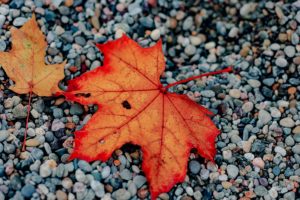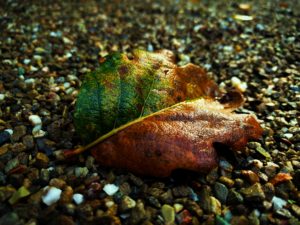Project 1: Take A Nature Walk
Let’s jump into some fall leaf science projects! Go for a walk outside on a nice day to collect leaves and get a closer look at the changes that are taking place around you with the change of the seasons. Your nature walk will be more fun if you bring someone along to help you collect and observe.
Here are some things to take with you for your fall leaf science projects:
- Plastic bags for bringing leaves and other items home
- A snack and water bottle if you are going for a long walk
- A notebook and pencil to help you remember things you see but can’t take home
- Camera to take pictures along the way
- Backpack or bag to keep it all in

What to collect:
- Leaves in every fall color you can find (look for yellow, orange, red, brown, purple, and even green ones)

When you get home, press the leaves between sheets of newspaper and some heavy books for a few days until they dry out. That way they will stay flat and keep their beautiful colors instead of curling up and looking dead.
- Some leaves or “needles” from trees that don’t lose their leaves in the fall
Compare them to the leaves you gathered that came from trees that do lose their leaves. How are they different? How are they similar?
- Leaves from plants that are not trees
Compare these leaves with the needles and leaves you gathered from trees. Did you find any leaves from plants that were changing color? Some plants that are not trees have leaves that will change colors and fall off, but most of the time, the whole plant that is above the ground will die and grow back from its roots in the spring. Some plants don’t grow back in the spring at all – they only live for one growing season.
What to notice:
- Are most of the leaves on a tree the same color, or do you see more than one color of leaves on the same tree?
- Do you see more trees that stay green and don’t lose their leaves during the fall or trees that do lose their leaves?
- How does the grass look in the places you walked? Is it still green? Is some of it turning brown?

- Do you notice any flowers blooming?
- Do you notice other things falling from trees – such as acorns or seed pods?
- If you see any animals, such as squirrels, what are they doing?
Most animals, plants, and trees are preparing for the winter during the fall months. Squirrels are gathering and storing food and finding homes that will provide them with shelter from the cold.
Plants lose their flowers and leaves, or else start to die, even though their roots might live through the winter. Except in very warm places, trees are losing their leaves to prepare for winter. Some trees also drop their seeds in the fall. The seeds get buried in the ground (sometimes they just get covered up by falling leaves) where they will be protected until springtime when they can start to grow into new trees. Grass also starts to turn brown as it gets colder.
Project 2: What Color Are Leaves?
What You Need:
- A few green leaves from 3 different kinds of trees
- 3 small drinking glasses
- Rubbing alcohol
- Plastic wrap
- A pan of hot tap water
- Coffee filters or filter paper
- Scissors
- Tape
- 3 pencils
What You Do:
1. Tear the leaves into small pieces. Put the pieces from each tree into different glasses (make sure each glass only has pieces from one type of tree!).
2. Get an adult to pour rubbing alcohol into each glass so that all the leaf pieces are covered.
3. Put a piece of plastic wrap over the top of each glass to keep the alcohol from evaporating (getting soaked up by the air).
4. Let an adult set the glasses in a pan of hot tap water and leave them for about 30 minutes. Check to make sure the alcohol in each glass has turned green before you take them out. If it hasn’t, refill the pan with hot water and put the glasses back in until the alcohol turns green.
5. While you wait, cut 3 strips out of the middle of the coffee filters. Make each strip about 1 inch wide. Tape one end of each strip to the middle of a pencil. Cut the other end of the strip into a point.
6. Once the alcohol in each glass has turned green, take the glasses out of the hot water.
7. Set a pencil with the paper strip taped to it over each glass so that the paper strip hangs down and the point touches the alcohol in the glass. If the paper is too long, roll some of it around the pencil to shorten it.
8. Let the glasses and papers sit for about 30 more minutes and then check to see if anything is happening. You should see the green color start to soak up on the paper. Wait even longer to see if any other colors come out!
What Happened:
Now that you have completed your fall leaf science projects, let’s chat about what happened. The alcohol and the heat from the hot water made the color in the leaves dissolve so you could see it in the alcohol. It is similar to what happens when you make tea. When you put a tea bag (filled with tea leaves) in a cup of hot water for a few minutes, the water becomes colored and flavored by the tea leaves. When you put the paper strips into the green-colored alcohol, the colors started to get soaked up by the paper and you should have seen a couple different shades of green. If you waited long enough, you might have been able to see other colors from the leaves appear on the paper – such as orange or yellow.
If you saw colors besides green, those are the colors that the leaves will change to in the fall! Did you see any difference in the colors from the different kinds of leaves you tested? The reason you couldn’t see all those colors in the green leaves or in the alcohol solution is because the chemical that causes the green color is much stronger than the chemical that causes orange and yellow. When you put the paper into the alcohol solution, the colors had a chance to separate, and the orange and yellow are were no longer covered up by the green. The same thing happens when leaves start to change colors – the chemical that makes them green starts to go out of the leaves, leaving the chemicals that make other colors behind, turning the leaves all the pretty colors of fall!






